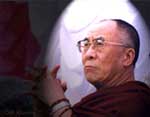www.123himachal.com
Dharamsala A Guide to Little Lhasa in India
His Holiness, the Fourteenth Dalai Lama of Tibet, was born on July 6, 1935 in a small farming village of Taktser in the province of Amdo, northeast Tibet. At the age of two, following a nationwide search, he was recognized as the reincarnation of his predecessor, the Thirteenth Dalai Lama. He was then brought to the capital, Lhasa, in October 1939, and formally installed as the head of state of Tibet on February 22, 1940.
In 1949 the newly-established communist China invaded Tibet. A year later, His Holiness Dalai Lama was requested by the Regent, the Cabinet and the National Assembly to assume full political authority though he was only fifteen, three years short of traditional majority. For the subsequent nine years, His Holiness theDalai Lama strove to achieve peaceful co-existence with the Chinese invaders. However, Image by Dr B C Khanna this proved impossible as the Chinese atrocities kept on mounting, creating ever more disillusionment among Tibetans. Tibetans aired their resentment to Chinese occupation by staging armed, popular uprisings, which spread to the entire nation and finally erupted in Lhasa on March 10, 1959. The Chinese responded violently to these uprisings.
When the situation became hopeless for Tibet, His Holiness was requested to flee the country in order to carry on the Tibetan struggle from the outside world. Escaping by night and in disguise, he left Lhasa on March 17, 1959, crossing safely into India on March 31, 1959 where he was warmly received and given asylum. Nearly 80,000 Tibetan refugees managed to follow His Holiness into exile and are now resettled primarily in India, Nepal, Bhutan, Switzerland, the United States and Canada. Seeking both to save his people and the Tibetan culture, His Holiness began a peaceful struggle to preserve Tibet's unique identity and regain the country's independence. On 10 December 1989 His Holiness was awarded the Nobel Peace Prize. The Nobel Committee emphasized "that the Dalai Lama, in his struggle for the liberation of Tibet, consistently has opposed the use of violence. He has instead advocated peaceful solutions based upon tolerance and mutual respect in order to preserve the historical and cultural heritage of his people."
His Holiness' Residense MCLEODGANJ
The Residence of His Holiness Dalai Lama is opposite the Tsuglag Khang, or the Central Cathedral, which is about ten minutes' walk from McLeod Gunj. Time permitting, His Holiness receives visitors in public audiences. Visitors can apply for public audiences at the Branch Security Office in McLeod Gunj, near Hotel Tibet. Applications for private audiences, however, need to be made in writing to His Holiness' Secretary several months in advance. Exploring Tibetan Culture The cultural life in Dharamsala is colourful and rich in tradition. The fairs and festivals are occasions for relaxation. To the local Indian traditions, Tibetan refugees have added their own festivals such as Losar (Tibetan New Year), and His Holiness the Dalai Lama's birthday which is celebrated on July 6 with the performance of Tibetan, Nepali and Gaddi dances revealing the cultural mosaic that McLeod Gunj is. More recently, tourists and students from the west have added rock music, stage musicals and contribute other Western influences to this melting pot of peoples and cultures.
[SHIMLA] [KULLU] [KANGRA ] [CHAMBA] [DHARAMSHALA] [PALAMPUR] [MANDI] [TREKKING][ECO_TOURISM]
[FAIRS & FESTIVALS] [LESSER KNOW HIMACHAL] [TIBETANWORLD] [COMMUNITY] [KINNAUR]
SHOW YOUR SUPPORT - ADD A LINK TO US ON YOUR WEB PAGE
WWW.123HIMACHAL.COM








